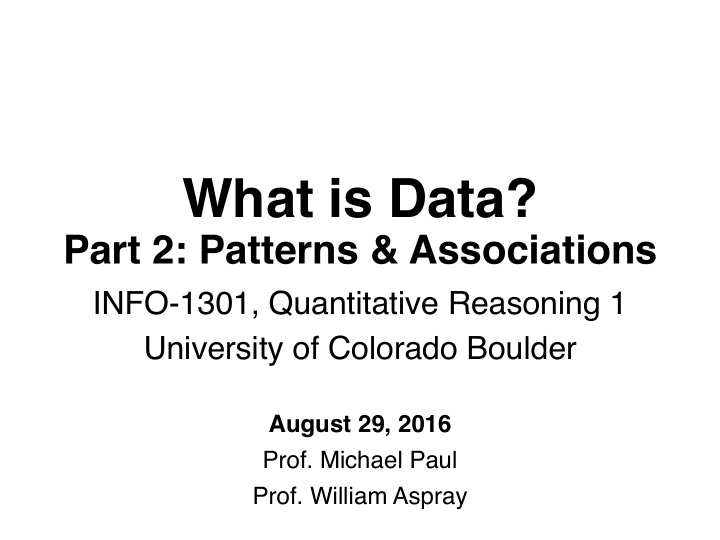



What is Data? Part 2: Patterns & Associations INFO-1301, Quantitative Reasoning 1 University of Colorado Boulder August 29, 2016 Prof. Michael Paul Prof. William Aspray
Overview This lecture will… • look at examples of relationships between variables, • define positive and negative associations, • and demonstrate how to plot variables and examine their associations in MiniTab. Most of today will be done with software.
Representation of data: matrix • Each row is an observation Name Gender Age (years) Height (cm) # of children Rows John Male 32 179.2 2 Mary Female 49 168.5 4 Alice Female 25 175.0 0 Columns • Each column is a variable Cells • Each cell is a value
Representing data in practice Now let’s recreate this matrix in MiniTab Name Gender Age (years) Height (cm) # of children John Male 32 179.2 2 Mary Female 49 168.5 4 Alice Female 25 175.0 0
Visualizing data Dot plots are only for numerical variables Dot plots display the values of one variable Each dot represents an observation Each dot’s position on the x-axis is the value of the variable for that observation
Visualizing data Scatterplots are an extension of dot plots for two variables Each dot’s position on the x-axis is the value of the first variable; the y-axis is the value of the second
Visualizing data What about categorical data? We won’t get into that today, but there are other options for categories (e.g., bar charts )
Relationships between variables Some variables are related in some way • Age and number of children • The older you are, the more likely you are to have children (in general) A relationship between variables is called an association
Relationships between variables Example: Height and weight • Dataset: measurements of the height and weight of 10,000 children as they grow up • Association: the taller a child is, the more they will weigh (in general) Data from: http://wiki.stat.ucla.edu/socr/index.php/SOCR_Data_Dinov_020108_HeightsWeights
Relationships between variables Example: Height and weight This is called a positive association • As the value of one variable increases, the value of the other variable also increases
Visualizing associations
Imagine that the dots in a scatterplot form a line • If the line is angled upward, the association is positive
Associations • Positive: • Negative: • No association: Variables that are not associated are called independent
Quantifying associations Correlation is a measurement of the association between variables • Different kinds of correlations • The correlation we’ll use in this class is the Pearson correlation • When people say “correlation” without specifying, this is what they usually mean • A correlation is a real number between [-1, 1] Karl Pearson, 1857-1936
Quantifying associations • Positive: • Negative: Correlation=1.0 Correlation=-1.0 • No association: Correlation=0.0
Quantifying associations Variables that are perfectly associated will have correlations of 1 or -1 Variables that are independent will have a correlation of 0 In real data, most correlations are somewhere in between
Quantifying associations Correlation= 0.557 Correlation= -0.101
Your turn
Loan application dataset http://support.minitab.com/en-us/datasets/basic-statistics-data-sets/loan-applicant-data/
Organize yourselves into groups of 4 Each group should investigate scatterplots and correlations of the following pairs of variables: • Group 1: Savings, Debt • Group 2: Employ, Savings • Group 3: Age, Debt • Group 4: Education, Credit Cards • Group 5: Residence, Employ Each group should also find at least one more pair with an interesting association
One more example
How should we interpret this result? What do these rows and columns correspond to?
Pounds of mozzarella cheese consumed per capita 2000 Year 2009 Number of people who earned a PhD in Civil Engineering Dataset from: http://tylervigen.com/
Spurious correlations Correlations/associations that are not meaningful – or whose meaning is different than it appears – are said to be spurious “correlation is not causation”
Spurious correlations Reasons for spurious associations: • Coincidence • Cheese ⟷ engineers probably falls into this category • Correlations will sometimes happen by chance
Spurious correlations Reasons for spurious associations: • Coincidence • Some other factor in the world is influencing both • Researchers have discovered a strong correlation between shark attacks and ice cream sales • In this example, summer time explains both variables • More people buy ice cream in the summer • More people swim in the ocean in the summer • In this example, the season (summer) is called a confounding variable
Spurious correlations Reasons for spurious associations: • Coincidence • Some other factor in the world is influencing both • The direction of causation is wrong • Sometimes an association is real, but for a different reason than you think • Example: healthy people are more likely to have lice than sick people • In the Middle Ages, people concluded lice make you healthy • Turns out, lice simply don’t like to live on sick people
Spurious correlations Reasons for spurious associations: • Coincidence • Some other factor in the world is influencing both • The direction of causation is wrong Correlations are interesting and important, but not conclusive
Understanding associations Why is it useful to measure correlations? • We can test if associations exist • Correlation does not imply causation, but no correlation does imply no causation • The discovery of associations in big data can lead to new ideas (hypothesis generation) • Some cases where associations can still inform decisions and predictions • People drive faster in red cars – direction of causality doesn’t matter to insurance companies
Recommend
More recommend